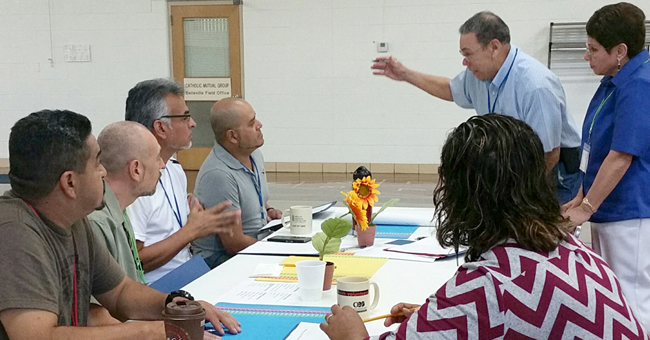Many Spanish-speaking Catholics still do not feel like they belong to their local parish.
That was one of the findings of a recent meeting of local Hispanic leaders at the diocesan pastoral center.
About 20 Hispanic leaders from local parishes and the Shrine of Our Lady of the Snows met Aug. 19 to identify pastoral needs in their communities and to consider ways in which the Diocesan Office of Hispanic Ministry can help address those needs.
Leaders shared information concerning the current programs in Spanish in the diocese, including beginnings of Spanish pre-Cana, and training in Spanish for liturgical ministries (lectors and extraordinary ministers of the Eucharist).
“Participants were given some time to privately reflect on their own reality in their parish or shrine and then share their responses with each other,” said Sister Joan Hornick, Hispanic ministry communications coordinator.
Participants were invited to reflect on such questions as: “What are the gifts and strengths of your parish community?” And “What are the needs of the parish with regard to Hispanic ministry?”
Afterward the group discussed the spiritual needs of the local Hispanic population.
The greatest need is for Spanish-speaking priests. “Many [Spanish speakers] feel they are not recognized as parishioners,” said Sister Joan. “Some feel they are invisible or that they are borrowing the English-speaking communities’ space.”
Meanwhile, the need for liturgical training in Spanish continues, as well as the need for Spanish-speaking staff members and volunteers in parishes. The need for lay formation in Spanish was also expressed.
Participants also reflected on the strengths of their various parishes. Some of the strengths included strong leaders who can respond to the needs of the community, the Church’s welcoming presence, its youth groups, Bible classes and religious celebrations.
The Office of Hispanic Ministry, along with Father Juan Gaspar, director of Hispanic Ministry at the Shrine, met in the days that followed to plan next steps. These include trainings for liturgical ministries as well as a refresher course for English-speaking priests to celebrate Mass in Spanish.







